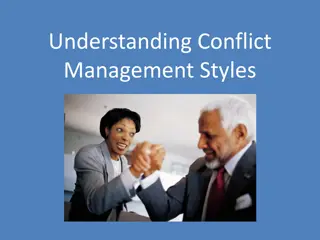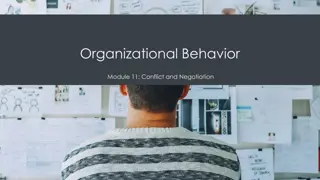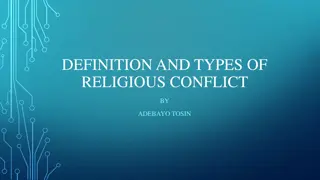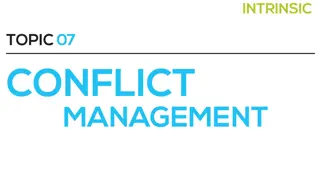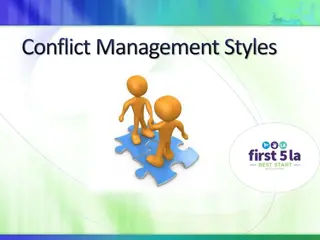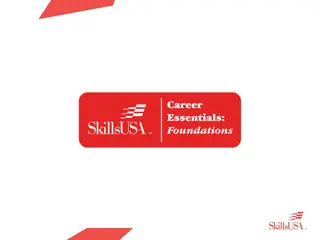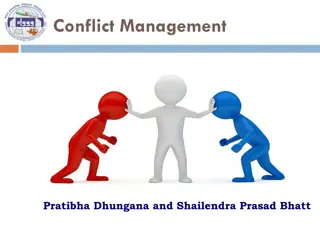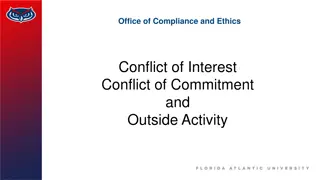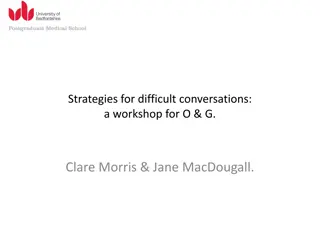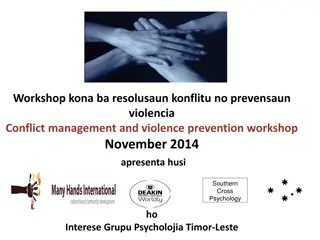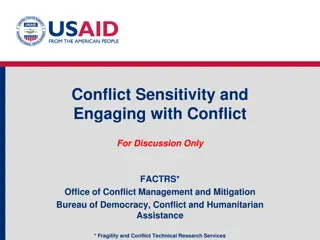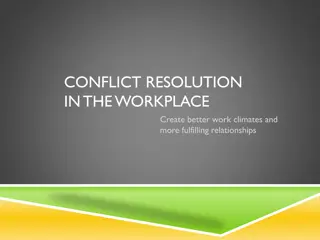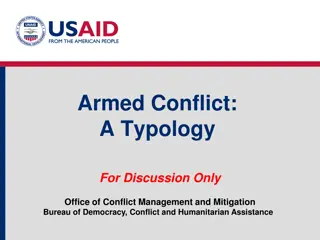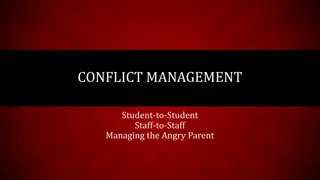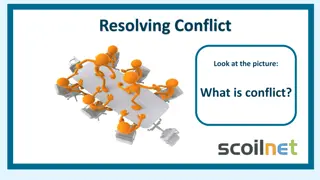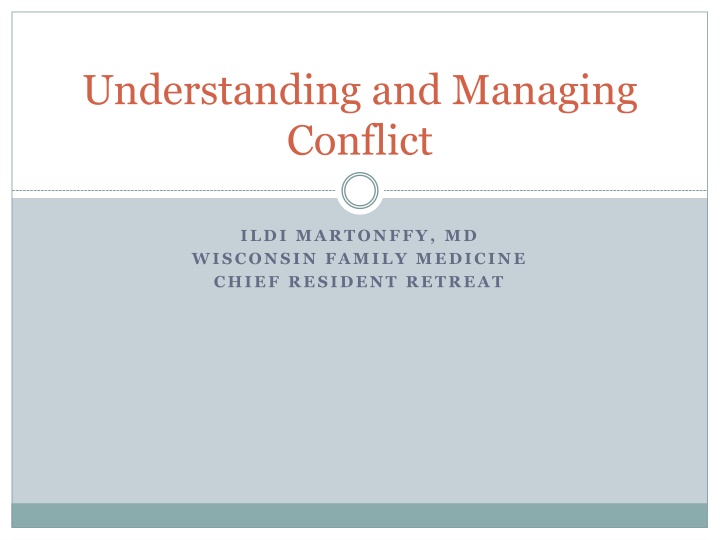
Managing Conflict in Residency Programs
Explore the dynamics of conflict in residency programs and learn how to effectively understand, discuss, and manage conflicts. Discover the potential benefits of conflict and strategies to address different sources of conflict. Gain insights into the desirability of conflict and the pitfalls of unresolved conflicts, all aimed at enhancing group performance and minimizing negative outcomes.
Download Presentation

Please find below an Image/Link to download the presentation.
The content on the website is provided AS IS for your information and personal use only. It may not be sold, licensed, or shared on other websites without obtaining consent from the author. If you encounter any issues during the download, it is possible that the publisher has removed the file from their server.
You are allowed to download the files provided on this website for personal or commercial use, subject to the condition that they are used lawfully. All files are the property of their respective owners.
The content on the website is provided AS IS for your information and personal use only. It may not be sold, licensed, or shared on other websites without obtaining consent from the author.
E N D
Presentation Transcript
Understanding and Managing Conflict ILDI MARTONFFY, MD WISCONSIN FAMILY MEDICINE CHIEF RESIDENT RETREAT
Disclosures No financial or other disclosures
Objectives At the end of this presentation, chiefs will be able to: Understand sources of conflict, discussing conflict, and managing conflict Apply these themes to a practical but challenging case Discuss four survival lessons for managing conflict
Why is conflict bad? How can conflict be good? Form groups of 3 with chiefs from different residency programs
Conflict is Contemporary view Traditional View o caused by troublemakers o bad o should be avoided o must be suppressed o inevitable between humans o often beneficial o natural result of change o can and should be managed
Desirability of conflict Eliminates or reduces likelihood of groupthink. A moderate level of conflict across tasks within a group results in increased group performance Dooley and Fryxell (1999) found that it was good to have conflict of ideas at the early stage of decision making. At a later stage when the ideas actually had to implemented conflicting ideas were more troublesome
Downfall of Conflict Some conflicts are hard to keep under control There can be a trend toward escalation and polarization. In settings were conflicts go unresolved and escalation continues, conflict almost always yields negative results: Low morale, poor performance, hard feelings Frequent personality conflict results in lower performance (Peterson & Behfar, 2003)
Five sources of conflict 1. Facts/Data Easy to solve (sometimes!) Limited Resources Money, time, people Politics/Power-- Autocratic boss, coalitions Values / Beliefs--History, principles culture Personalities often due to past / unresolved fear, pain ------------ 6. The ability of any individual, team, or system to tolerate change 2. 3. 4. 5.
Group work-team conflict In your group, think of a case that one of you experienced that involved conflict within a teamwork setting (okay to change details of the case to protect those involved). 1. Was it a conflict of FACTS/DATA LIMITED RESOURCES POLITICS/POWER VALUES - BELIEFS PERSONALITIES 2. What went well? What didn t go well? 3.
Discussing or raising conflict is often more difficult than resolving it.
Discussing/Raising conflict WHEN conflict comes to a chief s attention, a crucial skill is knowing how to raise / follow up. Raising conflict could mean one or more: 1) discuss with others, including residents, staff or program director, 2) monitor and discuss again with key person/s, 3) keep notes about the conflict, what was known/ what was done. Six factors to consider
Raising Conflict Timing Theirs what do you think I should do / when do you think I should do it? Yours as chief 1.
Raising Conflict Timing Depersonalize Don t attack Don t defend Neutral, simple, direct Avoid you and shoulds 1. 2.
Raising Conflict Timing Depersonalize Focus on behavior / Not blame Is this a pattern? Drill down to specifics (saw, heard, sensory) 1. 2. 3.
Raising Conflict Timing Depersonalize Focus on behavior Forget being right No rights, no wrongs Not a debate or trial Fairness & respect 1. 2. 3. 4.
Raising Conflict Timing Depersonalize Focus on behavior Forget being right Focus on the future Don t try and solve others problems Shared goals What is the thing that both sides want to achieve and how can we get that? 1. 2. 3. 4. 5.
Raising Conflict Timing De-personalize Focus on behavior Forget being right Focus on the future Be prepared to listen Listening may help / it s a great skill Invite / involve others 1. 2. 3. 4. 5. 6.
Raising Conflict What you ll get: Outbursts, rage, yelling, stomping, throwing, crying, withdrawal, threats, proclamations, meltdowns, withdrawal, demonization What you ll (usually) do: Respond with calm patience. Listen. Take measured action.
Back to your case How was this conflict discussed/raised? Who was it discussed with (who were the involved parties)? Is there anything that could have been done differently or better when the conflict was raised or discussed? If so, how?
Conflict resolution is the ideal. Conflict management is the reality.
Five Styles for Managing Conflict 1. Avoid 2. Appease 3. Compromise 4. Collaborate 5. Dominate
Think of teamwork situation you have witnessed How was the conflict dealt with? Avoid Appease Compromise Collaborate Dominate 1. What part of the approach worked? What didn t work? 2. Do you have a primary or secondary style for dealing with conflict? 3. Should your style vary by situation/setting? 4.
Four Survival Lessons from the Field
1. Keep your roles distinct Help others see differences in your roles Some personal (e.g., partner, friend) Some professional (e.g., clinician, chief) In the eyes of others: You = Your Role Don t take good / bad appraisals of chief work personally Work at being a good colleague / friend Strive to be a competent, fair chief
2. Move beyond your emotion Neutralize Use I statements ( I hear you raising your voice. Please stop. vs disguised you statement I hear you always yelling shut up already! ) Disengage find space ( Dealing with this type of issue isn t my strength you need to go to Dr Smith about it. ) Deflect Humor, stall, diversion De-compress Use confidants / mentors
3. Attend to relationships Confidants: closest circle, prize / nurture / reciprocate: don t overburden them Professional guides, mentors & coaches: trust, rely on, burden them Co-chief, peers, friends: high expectations, be explicit about hats / roles Self:sharpen the saw, learn, self-care Bystanders repeatedly engage them Trouble makers - make space for them, don t exclude them (they change too!) Casualties - expect them, care for them.
4. Keep returning to values Make your values a starting & end point in your roles & interactions They orient you when disoriented Help take setbacks, failures and dramatic successes in stride When behavior and values closely align, vision improves for new possibilities!
We discussed several themes about conflict that are likely to be useful for chiefs: Five common sources of conflict Six factors to consider when discussing/raising conflict Five styles of managing conflict We explored these themes in relation to a practical but challenging case We reviewed four survival lessons. Any final thoughts or questions? Thank you
Additional references Bolman LG, Deal TE. Reframing Organizations: Artistry, Choice and Leadership. Jossey-Bass. 1997 (3rd Edition is 2003) Daloz LA. Effective Teaching and Mentoring: Realizing the transformational power of adult learning experiences. Jossey-Bass. 1986. (2nd Edition called Mentor was published in 1999) Manning G, Curtis K. The Art of Leadership. McGraw-Hill. 2003. Morzinski JA. Mentors, colleagues and successful health science faculty: Lessons from the field. Journal of Veterinary Medical Education,2005;32(1):5-11. Morzinski JA, Weldelberger-Marcdante K. Building administrative skills: A framework for junior faculty. Academic Medicine, 1999; 74(5): 142. Patterson K, Grenny J, McMillan R, Switzler A. Crucial Conversations: Tools for talking when stakes are high. McGraw-Hill. 2002. Website: vitalsmarts.com 1. 2. 3. 4. 5. 6. Large thanks to Kathy Oriel, MD, who initially created this presentation.


